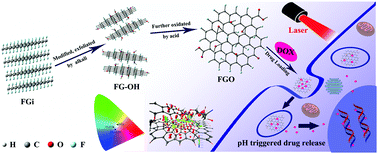Fluorinated graphene as an anticancer nanocarrier: an experimental and DFT study†
Abstract
The unique physicochemical properties and structure of fluorinated graphene (FG) hold great promise in biological fields, however, the strong hydrophobicity and chemical inertness heavily limit its further application, and the mechanism or utilization of FG as a drug nanocarrier has been rarely studied. Herein, a conceptual application of FG for loading doxorubicin (DOX) and cancer chemo-photothermal therapy is reported, and the interaction between FG and DOX was systematically investigated by density functional theory (DFT). To accomplish this, a mild method to synthesize stable and well-dispersed fluorinated graphene oxide (FGO) was developed, which exhibited excellent photothermal performance in the near infrared region (NIR), a high drug loading capacity (more than 200%), pH-triggered drug release, low cytotoxicity and good combination therapy effects. DFT results demonstrated that the introduction of fluorine provided more active sites for intermolecular interactions between DOX and FGO, and non-covalent interactions were the driving forces for drug loading and release. The presented method to employ FGO as an effective nanocarrier and the study of its interaction with drugs greatly broaden the further applications of FG, and provide new insights into developing novel drug delivery systems.



 Please wait while we load your content...
Please wait while we load your content...